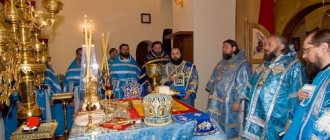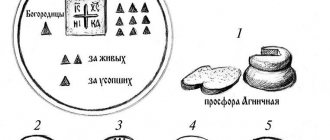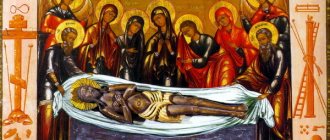The face is covered with air
The tradition of burying a Christian with a covered face began with the burial of Jesus Christ, whose face was covered by the sovereign. Sir - a handkerchief for wiping sweat from the face. This tradition, as an imitation, has survived to this day with the only difference that priests cover their faces with air (liturgical cloth) as a sign that he was the performer of the Mysteries of God, and novices, as a sign of their voluntary departure from the world, cover their faces with a special covering ( St. K. Nikolsky. Educational regulations for divine services. Volume III, p. 154.). These traditions are indicated in the Great Breviary of Peter Mogila. There is another explanation for why priests are buried with their faces covered: at these moments it is turned to the Almighty, and therefore hidden from people.
When liturgical texts are read
Readings of prayers, canons and singing occur in the following order:
- during ablution;
- immediately after vesting;
- before the start of the funeral procession;
- when carrying the coffin out of the temple.
For the deceased Orthodox layman, “Lord have mercy”, “The Trisagion” are sung and the canon “Following the departure of the soul from the body” is read. When burying an Orthodox priest, a different canon is provided.
Chapter VIII. Divine service of burial and remembrance of the dead
Without omitting a single instance where and when commemoration of the dead can be performed, the Church includes it in both public and private worship, and in home prayer.
According to our current Charter, daily worship, consisting of nine daily services, is performed in three sessions, divided into evening, morning and afternoon. And at each of them, in one form or another, briefly or at length, the remembrance of the dead is performed.300
Evening service
The first service of the coming day will be Vespers. The commemoration of the dead on it is carried out with a short general formula on a special litany: “For all our departed fathers and brothers, the Orthodox who lie here and everywhere.”
Vespers is followed by Compline, ending with the litany: “Let us pray...” The departed are also blessed there: pious kings, Orthodox bishops, ktitors, parents and all our fathers and brothers who have passed away before, those who lie here and are Orthodox everywhere.
Morning worship
The morning service begins with the Midnight Office. A significant part of this very early service, its entire second half, is devoted to prayer for the departed.
This prayer for the departed at the Midnight Office has a very important meaning and deep meaning.
Both in spiritual work and in everyday affairs, subsequent generations continue to build on the foundation laid by previous generations, continue the work begun by their ancestors, enjoy the fruits of their labors, reap what was sown by others (John 4:37), and work themselves, and they themselves sow so that those who come after them will reap the fruits of what is sown. Therefore, it is so natural that believers, people living on earth, preparing to go to work for the day and beginning their work day with prayer, first of all, even before deliberate prayer for themselves - it will be at the beginning of Matins - with gratitude, prayerfully remember those who they labored before and prepared the ground for their present work. Joyfully inheriting the fruits of the labors of the departed, joyfully continuing their work, the living invite the departed themselves to joy, inviting them to “bless the Lord” (Ps. 134:1). This is how that common joy begins, in which even now “both the sower and the reaper rejoice together” (John 4:36).
Due to its special importance, the midnight prayer for the dead is not only included in the public worship service, but is also separated into a special independent part, relatively isolated from the first part of the midnight office. At the same time, it is relatively short, because the Midnight Office is only the beginning of the daytime service and the worshipers still have a whole series of services ahead, and on weekdays the majority also have to work during the day. It is therefore limited to the Two very short Psalms which it follows. The Trisagion, two troparions and a funeral kontakion, concluded by the Theotokos, as which is used as the hypaka of the feast of the Dormition of the Most Holy Theotokos. Then follows a special funeral prayer, not repeated anywhere or at any other time, and upon dismissal - a brief commemoration of the departed at the end of the final litany, “Let us pray.” There is no commemoration by name here; it is performed using a general formula.
The Church considers the midnight prayer for the departed to be so important and necessary that it is omitted only during the week of Easter, when the completely exceptional structure of the entire service leaves no room for the Midnight Office.
In view of such deliberate prayer for the dead, performed before Matins, Matins itself usually does not have special funeral prayers. At it, as at Vespers, only a short petition is offered in a special litany “for all our departed fathers and brothers.”
Afternoon service
The daytime service for most of the year is combined with the Liturgy, at which, in addition to the general formula of commemoration at the special litany of “all those who have fallen before,” a name commemoration of the living and the dead is performed - at the proskomedia, during the removal of particles from the fourth and fifth prosphoras and from others, deliberately for the commemoration of those worn . At the Liturgy itself, after the consecration of the Holy Gifts, the living and deceased are commemorated for the second time by name. This is the most important, most effective commemoration. “Great benefit will come to the souls for whom prayer is offered when a holy and terrible Sacrifice is offered,” says Saint Cyril of Jerusalem.
The commemoration at the Liturgy of the living and the dead ends with the bold proclamation of the Church: “Wash away, Lord, the sins of those who were remembered here by Your honest Blood, by the prayers of Your saints.” The Church considers this proclamation as a confession of its firm faith, deep confidence that it will be so, that the Lord, by the power of the great Eucharistic Sacrifice and through the prayers of the saints, will certainly fulfill and is already beginning to fulfill this request at the moment of immersion in the Divine Blood of the particles taken in memory of the living and the deceased.
The commemoration of the living and the dead at the proskomedia and after the consecration of the Gifts, although unspoken, in its meaning, strength and effectiveness cannot be compared with any other prayerful commemorations - health prayers, memorial services for the dead - or any other pious deeds in memory of the living and deceased. It cannot be compared even with the public commemoration at the same Liturgy at the Great and Sublime Litany and at the special funeral litany.
The commemoration of the departed at the proskomedia and during the singing of “It is Worthy to Eat” or the venerable person is never omitted when the full Liturgy is celebrated. The funeral petition is also never omitted at the special litany - at the Liturgy, Vespers and Matins - when this litany is pronounced at these services. It is not canceled even on the first day of Easter.
Each degree of church remembrance and holidays introduces its own changes into the harmonious system of commemoration, starting from almost exclusively funeral prayers on parental Saturdays, decreasing on simple Saturdays and weekdays, decreasing even more on forefeasts, afterfeasts and holidays, according to the degree of each. Moreover, the use of the chants of the Octoechos on weekdays is, for the most part, the standard for funeral prayers. The more hymns from the Octoechos, the more intense the prayer for the dead. And vice versa. As borrowings from the Octoechos decrease, funeral prayers also decrease.
Ecumenical Parents' Saturdays
Funeral prayers are most intensified on the two ecumenical parental Saturdays before the weeks of the Meat and Pentecost. On these two days, living members of the Church are invited to forget themselves, as it were, and, reducing to a minimum the memories of the holy saints of God, in intensified and multiplied prayer for the deceased glorified members of the Church, relatives and strangers, known and unknown, of all ages and conditions, of all times and peoples, in general all those who have died, who have died in the true faith, to fully demonstrate their brotherly love for them. On these two ecumenical Saturdays, according to the Church Charter, the service of Menaion is completely abandoned, and the honoring of the saints is “transferred to another day.” The entire service on Saturday is a funeral service, exceptional in its content, specially compiled for these two days. Even if a temple holiday occurs on one of these Saturdays, or on the meat feast Saturday of the Presentation, the funeral service is not canceled, but is transferred to the tomb, if there is one, or transferred to the previous Saturday, or to the previous Thursday.
At Vespers and Matins on these two Saturdays, commemoration is performed mainly of all those who have previously died. The commemoration of relatives is somewhat postponed, giving way to a general commemoration of all the deceased. But in order to satisfy the kindred feeling of those praying, who wish on these especially memorial days to pray for their departed relatives, the Rule on these two ecumenical Saturdays, in addition to commemoration at Vespers and Matins, also appoints a great requiem after Vespers as an indispensable, along with the prescribed, compulsory service. This is like a second funeral matins, but of a slightly different, more intimate nature and content, appointed to commemorate deceased relatives. The canon here is one of the usual Saturday funeral canons of the Octoechos, containing a general prayer for repose and forgiveness of sins. The deep difference in the content of funeral prayers at Matins and Panikhida should undoubtedly serve as the basis for the difference in commemoration there and here. The memorial service is reserved mainly for the name-calling of the temple synodics and the memorials of pilgrims. At Matins, one should limit oneself to the proclamation in the appropriate places of only more or less brief or lengthy general
memorial formulas.
At Ecumenical Saturday services, the Church commemorates “all Orthodox Christians who have previously died.” With this, she reminds believers that in addition to their beloved relatives and friends, they also have many brothers in Christ, whom they, without seeing them, should love and for whom, even without knowing their names, they should pray. By this order, the Church tries to preserve prayer for every Orthodox Christian, even when none of those who personally knew him remain alive, when his name is forgotten on earth.
Thus, the two ecumenical Saturdays, primarily before other occasions of commemoration of the dead, encourage Christians to pray first of all “for all Orthodox Christians who have fallen asleep from time immemorial,” providing them with prayer “for the length of days” (Ps. 92:6).
Saturdays of Lent
On the second, third and fourth Saturdays of Lent, a deliberate commemoration of the dead is also performed. These are also “parental” Saturdays. But here there are much fewer funeral prayers and their character is not as exclusive and comprehensive as there. Those two are universal Saturdays, these are simply parental Saturdays. There, in the first place is the commemoration of all those who have died before, and along with it, as if in addition to it, the commemoration of our relatives. Here, the commemoration of relatives comes first, accompanied by the commemoration of all the deceased. And because the commemoration of relatives is performed in the first place and at Matins, the Charter does not appoint a special memorial service after Vespers on these days, but transfers the ordinary funeral canon of Octoechos to Compline.
Intensified funeral prayers on Saturdays of Lent are established to compensate for the liturgical commemoration that cannot take place on weekdays of fasting. The glorification of the saints of the Menaion that happened on these Saturdays is not canceled, and next to the funeral chants of the Octoechos and Triodion, the hymns of the Menaion are also sung in honor of the saint celebrated on this day.
Saturdays of Lesser Fasts
Chapter 13 of the Typikon, which sets out the Saturday service, “when alleluia is sung,” refers to the Saturdays of the small fasts: Nativity, Apostolic and Dormition. If the memory of a minor saint occurs on Saturday, then in this case a service with alleluia should be performed, but on a Saturday, similar to the funeral service of the three Lenten memorial Saturdays.
The funeral service according to the 13th chapter of the Typikon can be performed on other Saturdays throughout the year, but on the condition that on that day there will be a minor saint who does not have any holiday sign. All funeral chants are not deliberate and are taken from the Octoechos of the ordinary voice. The service of the Menaion is not abandoned, but is sung along with the Octoechos.
The most outstanding features of Saturday's memorial service in all cases are:
a) the use at Vespers, Matins, hours and Liturgy of the troparion and kontakion for the repose instead of the completely omitted troparions and kontakions of the Menaion;
b) poetry on the special rite of the immaculate at Matins;
c) recitation of the funeral litanies at Matins.
Our Russian Orthodox Church also has two more special memorial days: the Saturday before the day of the Holy Great Martyr Demetrius of Thessalonica (October 26) and on St. Thomas Week, the so-called Radonitsa.
Dmitrov Saturday
The commemoration of the dead on Saturday before October 26 was established in 1380 by Grand Duke Dimitri Ivanovich Donskoy to commemorate the soldiers who fell on the Kulikovo field in the battle with Mamai. But the custom of autumn commemorations of the dead was in ancient times among pagan peoples. The Slavs also had it.
Initially, the autumn commemorations of the deceased were not timed to a specific day. It is possible that after the Battle of Kulikovo, Dimitri Donskoy, having performed the first solemn commemoration of those who fell in the battle in the monastery of St. Sergius, in view of the wishes expressed to him by the boyars for the future “to create the memory of those who laid down their heads,” and established an annual commemoration of them on this Saturday.
Naturally, this commemoration of the soldiers was combined with the usual autumn commemoration of all the dead. This is how Dmitrov’s parental Saturday appeared. Dmitrov Saturday can be between October 19 and 25. With the exception of the feast of the Kazan Mother of God on October 22, on all other days, if there is no temple or locally revered holiday, a funeral service “with alleluia” can be performed according to the 13th chapter of the Typikon.
Radonitsa
The commemoration of the dead, known as Radonitsa, takes place on St. Thomas Week, most often on Tuesday.
Radonitsa owes its origin to the statutory prescription according to which, during Lent, the commemoration of the deceased on the occasion of deliberate memorial days (3rd, 9th and 40th), which was not performed at the time due to the nature of the Lenten service, is transferred to one of the nearest weekdays , in which not only a memorial service, but also a full Liturgy can be celebrated. This is what Tuesday of Thomas Week is.
Commemoration on Radonitsa, although not provided for by our Church Charter, can also be considered as being performed to make up for the omission of all funeral prayers and public commemoration of the departed from Holy Thursday to Antipascha Monday.
Thursday of the seventh week of Easter
Ancient Rus' had one more day on which, mainly in cities, a special memorial prayer was performed. It was the Thursday before the feast of the Holy Trinity. On this day, the Russian people performed a work of brotherly love for the dead, for completely unknown people, even for villains, robbers killed in robbery and executed criminals. All parting funeral rites are performed for them, which are usually used to see off from this life all Orthodox Christians who have died piously.
Until the second half of the 18th century, we did not have common city cemeteries far from churches. There were no rural cemeteries far from churches. For the burial of unknown persons, for example, those who came from unknown places, those killed near a city or village of travelers, as well as for the burial of those killed in robbery and executed, special places were allocated where special buildings were built, where the bodies of such dead were collected before burial. And their burial took place without performing a church funeral each time. This building with the adjacent cemeteries was called “the poor house”, “poor house”, “God’s house”, “Bozhedomka”. The supervision of these houses and cemeteries was entrusted to a special clerk, who kept appropriate records, adding the names of these deceased to a special list.
On the Thursday before the feast of the Holy Trinity, Orthodox Christians flocked to the “poor houses”, bringing with them everything necessary for the funeral service: candles, incense, kolivo, clothes, shrouds, coffins for those not yet buried, as well as various foodstuffs for the funeral meal. The day before, on Wednesday of the 7th week of Easter, in the church closest to the poor houses, after Vespers, a memorial service was celebrated for the departed, and on Thursday the Liturgy. It was carried out by a council of clergy. At the end of the Liturgy, the clergy and the “nationwide crowd,” with a procession of the cross and ringing of bells, left the church for the skudelnitsa, where the burial ceremony was performed, at which those whose names are known were remembered by name. And if the names of these people were not there, then, after reading the names, they commemorated: “Remember, Lord, the souls of Your departed servants, and You, Lord, weigh their names, like the Orthodox Christians who lie here and everywhere, and we make remembrance of them: and forgive them every sin.” And until the end the burial takes place according to custom. After burial, the bodies of the dead are covered with linen, and the abbot and priests sprinkle the earth over the linen. Then they set up a table and a kutya on it and begin the requiem service, and at the litanies they commemorate the dead in the same way as at the burial, and at the previous ones, the deceased want them and sing the requiem service according to the rules.
Due to the circumstances of the time, many Orthodox Christians, often against their wishes, are left without a church burial. Therefore, it would be desirable for it to be established on the Thursday before the day of the Holy Trinity to perform the succession of the worldly people, to perform the funeral service in absentia for all those buried without a funeral service during the year, with the commemoration in all places of all Orthodox Christians in the past year who died and were left without a church burial, “them You Yourself, Lord, weigh the names.”
Commemoration of the poor
On the same Thursday of the 7th week of Easter in Rus', the commemoration of the deceased beggars and orphans and all those without relatives who could remember them was performed. For this purpose, the names of such people were recorded in synodics and commemorated at home prayer and especially at the Divine Liturgy, They gave alms for them and performed a deliberate commemoration on the indicated Thursday. To those who remember the poor, the Church asks: “Reward them (Lord) with Your rich and heavenly gifts. Grant them heavenly instead of earthly, eternal instead of temporary, incorruptible instead of perishable” (Prayer at the Liturgy of St. Basil the Great).
3rd, 9th, 40th day and year
In addition to the general days of remembrance of the dead, from deep early Christian antiquity there is a custom to perform a special commemoration for each deceased individual on certain days closest to their death. The church charter mentions commemoration on the 3rd, 9th, and 40th days after death. Sometimes we set aside the twentieth day as a special memorial day. In addition, just as the living usually celebrate their birthdays and name days with deliberate prayer and a fraternal meal, the custom has been established to commemorate our dearly departed loved ones annually on the day of death (birth into a new life) and the name day.
When performing private commemorations, the charter does not allow any changes or deviations from the exact fulfillment of everything that is prescribed for that day at a public service, or any funeral additions beyond what is allowed for that day. And the Great Moscow Cathedral of 1666–1667, speaking about the commemoration of the dead on these days, limits commemoration to the performance of a requiem the day before after Vespers, the reading of the Apostle and the Gospel at the Liturgy of the dead, and the performance of a litany according to the prayer behind the pulpit and again after the dismissal of the Liturgy at the tomb, if the latter is nearby .
Public, deliberate funeral prayer is always adapted to those everyday days when it can be performed in full accordance with the rules. If the day of remembrance falls on a holiday, then the funeral prayer is moved forward two days, so that not only holidays, but also their eves are freed from a requiem service that could not be performed in connection with public worship.
Sorokoust
The main meaning of the fortieth commemoration is that the deceased be remembered during the celebration of forty Liturgies, even if this commemoration is limited only to secret commemoration at the proskomedia and after the consecration of the Holy Gifts.
Sorokoust is forty Liturgies. The Church Charter prescribes the celebration of Liturgies “until the completion of the forty days of offering,” which means until the fulfillment of 40 Liturgies. Therefore, if the commemoration did not begin on the very day of death or if it was not performed continuously from day to day, then it should be continued after the fortieth day until the full number of 40 liturgies were performed, even if they had to be performed a long time after the fortieth day. The fortieth day itself must be celebrated in its own time or on the day closest to it when such a commemoration can be made.
Regular Saturdays
Every Saturday, especially when the Octoechos is sung, among the other days of the week is primarily the day of remembrance of the dead. The Holy Church chose these Saturdays primarily for the remembrance of all her children who have died from earthly labors, both those whom she has among her holy prayer books, and all the others, although sinners, who lived in faith and died in the hope of the resurrection. And in the hymns set for Saturday, she boldly unites all the departed, both Orthodox and non-Orthodox, pleasing the former and calling on them to pray for the latter. On Saturday, a funeral service can also be held according to the rite set out in the 13th chapter of the Typikon. But such a service can be performed if on a given Saturday there is no memory of a great saint or there is no holiday at all for which a service with doxology is due.
At the main services of public worship, the Church Charter on ordinary Saturdays allows relatively little of the funeral. But in addition to the daily circle of services, on the eve of Saturday, on Friday after Vespers, a great memorial service is scheduled, at which the 17th kathisma with special funeral refrains is sung and the funeral canon of the Octoechos of the ordinary voice is sung.
Commemoration of soldiers on August 29
In 1769, by order of Empress Catherine II, it was established to commemorate Orthodox soldiers on this day with a memorial service after the Liturgy. This commemoration, scheduled for such an exceptional day of the year, when all funeral prayers are eliminated from all services, even from the midnight office, is in complete contradiction with the Church Charter and is a sad witness of the departure from the Church and from living according to Her covenants, which began in the 18th century, and the disregard church statutes and traditions to please the powers that be.
Blessing of koliva during the holidays
To publicly commemorate the dead, to say funeral prayers, and in general always mournful prayers, would be inappropriate for the festive joy. But doing good deeds in memory of the dead is not only not forbidden on holidays, but is also highly praised. Orthodox Christians are especially invited to this.
At the end of the 3rd chapter of the Typikon it is indicated: “The rite of blessing is koliva, which is kutia or boiling wheat with honey, mixed and brought to church in honor and memory of the Lord’s holidays or saints of God.” In our country, this rite as a festive one is almost completely forgotten and kutya is considered an exclusive property of funeral services. The Church Charter, designating its bringing to church not only when commemorating the dead, but also on the feasts of the Lord and saints, thereby inspires us to look at kutya somewhat differently. This is a tasty and sweet dish, one of the dishes of the holiday meal, a sweet, tasty and nutritious dish - one of the best. The meal is considered by the Rule as a direct continuation of the Liturgy or Vespers service. Now the meal was separated from the worship service, especially in parish churches. But on holidays, as if wishing to remind of the ancient practice of communication in a festive meal of all those who prayed during the festive service, the Rule commands that at least one of the festive dishes be brought to the church at the end of Vespers and Liturgy. Kolivo brought to the Church is like a small meal, arranged by wealthier parishioners, from which the clergy and everyone present at the service, especially the poor, feed. In ancient times, the Greeks, according to the testimony of Saint Simeon of Thessalonica, brought wine along with kutia, as a drink common in the East. In ancient Rus', in the absence of their own grape wine, in such cases the local national drink was brought - honey. Thus, the blessing of koliv was, although a small, but complete meal, at which not only food, but also drink was provided.
When blessing the koliva, it is proclaimed: “For Thy glory, and in honor of the Holy One, (name of the rivers), this was offered by Thy servants and in memory of those who died in pious faith.”
The rite of blessing koliv reminds those who have, for the sake of the holiday and in memory of the departed, to share with the have-nots and other dishes of their holiday meal, and not the leftovers, but the best, sweet pieces, reminds them that on holidays they should generally strengthen their good deeds, multiply alms of all kinds, performing it for the sake of the holiday and in memory of the deceased, as if repaying their debt to the poor. Giving to the poor what we would be happy to treat our dear departed on this holiday is the best way to commemorate them on a holiday, pleasing to the Lord.
How to see off the deceased - prayers, bell ringing, chants
When transferring the priest's body to the church and to the grave, the Holy Scriptures, cross and banners are carried in front of the coffin. The procession is accompanied by a funeral bell ringing, as it represents a religious procession. Each temple begins to ring its bells as a procession passes near it. The procession stops in front of the temple to hold a funeral litany. During the transfer of the deceased, in addition to the litiya, the introductory verses of the canon “Helper and Patron” are heard. In the church, four candlesticks are placed on four sides near the coffin. The body of the deceased priest is carried by the clergy.
History of burial ranks
It is curious that the order of rites known to us today appeared relatively recently. The idea of a special order for the funeral of clergy arose in Byzantium in the 14th century. Before that, the Byzantine church had a common burial rite for all, which was most reminiscent of how Orthodox monks are buried today. So, a special order was invented in Byzantium and spread by the end of the 14th century. In the 15th century, the same order was adopted by the Russian kingdom. It is noteworthy in this story that historically it was not the priestly burial rite that arose from the complication of the “ordinary”, secular rite, but on the contrary: the funeral rite of the laity arose as a result of the simplification of the original rite, which is still applied only to clergy. In Rus', the new system of rites was spread by Metropolitan Cyprian: this was specifically expressed in the corrections that he made to the Service Book and Trebnik.
As a result, the rite, as the Russian Orthodox Church knows it today, was first fully formulated in the Trebnik of Kyiv Metropolitan Peter Mogila in the 17th century - and since then it has not changed. In modern breviaries, the rite of burial over a member of the white clergy is listed as “Mortnal succession over a deceased priest.” It is noteworthy that the same burial rite is also given to bishops - they formally belong to the black clergy, but an exception is made for them due to historical reasons.
It is also curious how, over the centuries, the Russian Orthodox Church has tried to resolve the issue of burial of priests subjected to disciplinary sanctions. For example, how should a priest who was removed from ministry and soon died without being reinstated be buried? Ultimately, it was decided that if a priest was facing temporary suspension and repented before his death, then he would be buried as a priest. If he was demoted to a layman and deprived of his dignity forever, then he was buried as a layman.
Temples in Moscow cemeteries
Completion of readings and songs
In the final part of the rite, the priests sing stichera - hymnographic chants dedicated to a specific church event or celebration. The texts of the stichera on the verse consist of eight parts, called voices, each of which is divided into excerpts from psalms. Each voice passage is preceded by a specific verse: for example, the first voice passage is always preceded by Psalm 142:8: “Bring my soul out of prison to confess to Your Name.” At a priest's funeral, three passages from each voice are read. At the end, a prayer of permission is read, after which a rolled up scroll with its text is placed in the hand of the deceased.
FUNERAL ORGANIZATION
ACCORDING TO THE ORTHODOX RITE
More details
Liturgical plate
During the earthly life of Jesus Christ, the burial tradition included covering the face of the deceased with a special scarf. This custom continues to this day at priestly funerals. The face of the deceased is covered with air - an embroidered cloth placed on the Sacred Gifts during the service. This denotes the special involvement of the clergyman in the celebration of the Holy Mysteries of the Body and Blood of Christ. The funeral service and burial are performed with this embroidered scarf.
Organizing a funeral requires a set of actions that are carried out promptly, carefully, taking into account specific circumstances.
Funeral arrangements
How monks are buried on Holy Mount Athos
Mount Athos also has its own special traditions and procedures for burying its inhabitants. More often, such norms were associated with religious dogmas, but some of them are also explained by the specific climatic and other characteristics of the area itself around the shrine on the mountain.
Firstly, the inhabitants of the Holy Mountain are buried without a coffin, simply sewing the body into a cassock. It is believed that in this way the body gets rid of unnecessary barriers between itself and God, its body will be accepted by the earth faster, and its soul will reach God. Three years after the burial, the monks dig up the body and see if the bones have gotten rid of the flesh.
It is believed that if there are only relics without flesh, then the monk was accepted by God, and if not, the monk was not sinless, the remains should remain in the ground and turn to dust, and one should pray even more diligently for the soul of the buried monk.
Another feature of burial on Mount Athos is the refusal to wash the body and dress it in clean clothes. The fact is that the dogma of faith states that cleanliness and hygiene are unnecessary human habits. Those who strive for God and have found peace in a monastery do not need to worry about this, since it is better to direct all their thoughts only towards spiritual purity.
Funeral chime
When burying clergy, a special funeral bell rings, varying depending on what stage of the funeral rite is currently taking place. For example, while the funeral procession is walking to the grave, a single chime of bells sounds. When the funeral service is performed for the deceased and the Gospel is read, the number of strikes of the bell corresponds to the number of the passage from the psalm that is now being read. When the body is brought into the church and when it is lowered into the grave, the bell ringer must make a trezvon - a three-beat strong ringing of several bells at the same time.










